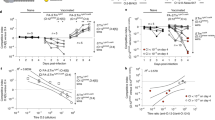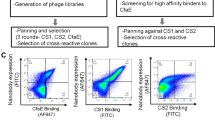Abstract
We previously demonstrated that oral application of the recombinant single-domain antibody fragment (VHH) clone K609, directed against Escherichia coli F4 fimbriae, reduced E. coli-induced diarrhoea in piglets, but only at high VHH doses. We have now shown that a large portion of the orally applied K609 VHH is proteolytically degraded in the stomach. Stringent selection for proteolytic stability identified seven VHHs with 7- to 138-fold increased stability after in vitro incubation in gastric fluid. By DNA shuffling we obtained four clones with a further 1.5- to 3-fold increased in vitro stability. These VHHs differed by at most ten amino acid residues from each other and K609 that were scattered over the VHH sequence and did not overlap with predicted protease cleavage sites. The most stable clone, K922, retained 41% activity after incubation in gastric fluid and 90% in jejunal fluid. Oral application of K922 to piglets confirmed its improved proteolytic stability. In addition, K922 bound to F4 fimbriae with higher affinity and inhibited fimbrial adhesion at lower VHH concentrations. K922 is thus a promising candidate for prevention of piglet diarrhoea. Furthermore, our findings could guide selection and improvement by genetic engineering of other recombinant antibody fragments for oral use.



Similar content being viewed by others
References
Adey NB, Stemmer WPC, Kay BK (1996) Preparation of second-generation phage libraries. In: Kay BK, Winter J, McCafferty J (eds) Phage display of proteins and peptides. A laboratory manual. Academic, San Diego, pp 280–290
Amin N, Liu AD, Ramer S, Aehle W, Meijer D, Metin M, Wong S, Gualfetti P, Schellenberger V (2004) Construction of stabilized proteins by combinatorial consensus mutagenesis. Protein Eng Des Sel 17:787–793
Arnold U, Ulbrich-Hofmann R (1997) Kinetic and thermodynamic thermal stabilities of ribonuclease A and ribonuclease B. Biochemistry 36:2166–2172
Becker T, Rapp W (1979) Characterization of human pepsin I obtained from purified gastric pepsinogen I. Klin Wochenschr 57:711–718
Daugherty PS, Chen G, Iverson BL, Georgiou G (2000) Quantitative analysis of the effect of the mutation frequency on the affinity maturation of single chain Fv antibodies. Proc Natl Acad Sci USA 97:2029–2034
Foote J, Winter G (1992) Antibody framework residues affecting the conformation of the hypervariable loops. J Mol Biol 224:487–499
Frenken LG, Egmond MR, Batenburg AM, Verrips CT (1993) Pseudomonas glumae lipase: increased proteolytic stability by protein engineering. Protein Eng 6:637–642
Frenken LG, van der Linden RH, Hermans PW, Bos JW, Ruuls RC, de Geus B, Verrips CT (2000) Isolation of antigen specific llama VHH antibody fragments and their high level secretion by Saccharomyces cerevisiae. J Biotechnol 78:11–21
Hamers-Casterman C, Atarhouch T, Muyldermans S, Robinson G, Hamers C, Songa EB, Bendahman N, Hamers R (1993) Naturally occurring antibodies devoid of light chains. Nature 363:446–448
Harmsen MM, Ruuls RC, Nijman IJ, Niewold TA, Frenken LG, de Geus B (2000) Llama heavy-chain V regions consist of at least four distinct subfamilies revealing novel sequence features. Mol Immunol 37:579–590
Harmsen MM, Smits CB, de Geus B (2002) Stimulation of chymosin secretion by simultaneous expression with chymosin-binding llama single-domain antibody fragments in yeast. Appl Microbiol Biotechnol 60:449–454
Harmsen MM, Van Solt CB, Hoogendoorn A, Van Zijderveld FG, Niewold TA, van der Meulen J (2005) Escherichia coli F4 fimbriae specific llama single-domain antibody fragments effectively inhibit bacterial adhesion in vitro but poorly protect against diarrhoea. Vet Microbiol 111:89–98
Jermutus L, Honegger A, Schwesinger F, Hanes J, Pluckthun A (2001) Tailoring in vitro evolution for protein affinity or stability. Proc Natl Acad Sci USA 98:75–80
Keil B (1992) Specificity of proteolysis. Springer, Berlin Heidelberg New York
Kurtzman AL, Govindarajan S, Vahle K, Jones JT, Heinrichs V, Patten PA (2001) Advances in directed protein evolution by recursive genetic recombination: applications to therapeutic proteins. Curr Opin Biotechnol 12:361–370
Lefranc MP (2004) IMGT, The International ImMunoGeneTics Information System, http://www.imgt.cines.fr. Methods Mol Biol 248:27–49
Low AG (1982) The activity of pepsin, chymotrypsin and trypsin during 24 h periods in the small intestine of growing pigs. Br J Nutr 48:147–159
Markert Y, Koditz J, Mansfeld J, Arnold U, Ulbrich-Hofmann R (2001) Increased proteolytic resistance of ribonuclease A by protein engineering. Protein Eng 14:791–796
McCafferty J, Johnson KS (1996) Construction and screening of antibody display libraries. In: Kay BK, Winter J, McCafferty J (eds) Phage display of peptides and proteins. Academic, San Diego, pp 79–111
Morgavi DP, Newbold CJ, Beever DE, Wallace RJ (2000) Stability and stabilization of potential feed additive enzymes in rumen fluid. Enzyme Microb Technol 26:171–177
Nagy B, Fekete PZ (1999) Enterotoxigenic Escherichia coli (ETEC) in farm animals. Vet Res 30:259–284
North MJ (1989) Prevention of unwanted proteolysis. In: Beynon RJ, Bond JS (eds) Proteolytic enzymes. A practical approach. IRL, Oxford, pp 105–123
Padlan EA (1994) Anatomy of the antibody molecule. Mol Immunol 31:169–217
Reilly RM, Domingo R, Sandhu J (1997) Oral delivery of antibodies. Future pharmacokinetic trends. Clin Pharmacokinet 32:313–323
Schmidt P, Wiedemann V, Kuhlmann R, Wanke R, Linckh E, Losch U (1989) Chicken egg antibodies for prophylaxis and therapy of infectious intestinal diseases. II. In vitro studies on gastric and enteric digestion of egg yolk antibodies specific against pathogenic Escherichia coli strains. Zentralbl Veterinarmed B 36:619–628
Sellwood R, Gibbons RA, Jones GW, Rutter JM (1975) Adhesion of enteropathogenic Escherichia coli to pig intestinal brush borders: the existence of two pig phenotypes. J Med Microbiol 8:405–411
Van der Linden RH, Frenken LG, De Geus B, Harmsen MM, Ruuls RC, Stok W, de Ron L, Wilson S, Davis P, Verrips CT (1999) Comparison of physical chemical properties of llama VHH antibody fragments and mouse monoclonal antibodies. Biochim Biophys Acta 1431:37–46
Van der Vaart JM (2002) Expression of VHH antibody fragments in Saccharomyces cerevisiae. In: O’Brien PM, Aitken R (eds) Antibody phage display: methods and protocols. Methods in molecular biology, vol 178. Humana, Totowa, pp 359–366
Wedemayer GJ, Patten PA, Wang LH, Schultz PG, Stevens RC (1997) Structural insights into the evolution of an antibody combining site. Science 276:1665–1669
Wiedemann V, Kuhlmann R, Schmidt P, Erhardt W, Losch U (1990) Chicken egg antibodies for prophylaxis and therapy of infectious intestinal diseases. III. In vivo tenacity test in piglets with artificial jejunal fistula. Zentralbl Veterinarmed B 37:163–172
Yokoyama H, Peralta RC, Sendo S, Ikemori Y, Kodama Y (1993) Detection of passage and absorption of chicken egg yolk immunoglobulins in the gastrointestinal tract of pigs by use of enzyme-linked immunosorbent assay and fluorescent antibody testing. Am J Vet Res 54:867–872
Zahnd C, Spinelli S, Luginbuhl B, Amstutz P, Cambillau C, Pluckthun A (2004) Directed in vitro evolution and crystallographic analysis of a peptide-binding single chain antibody fragment (scFv) with low picomolar affinity. J Biol Chem 279:18870–18877
Author information
Authors and Affiliations
Corresponding author
Rights and permissions
About this article
Cite this article
Harmsen, M.M., van Solt, C.B., van Zijderveld-van Bemmel, A.M. et al. Selection and optimization of proteolytically stable llama single-domain antibody fragments for oral immunotherapy. Appl Microbiol Biotechnol 72, 544–551 (2006). https://doi.org/10.1007/s00253-005-0300-7
Received:
Revised:
Accepted:
Published:
Issue Date:
DOI: https://doi.org/10.1007/s00253-005-0300-7




